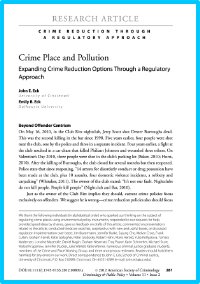Crime Place and Pollution: Expanding Crime Reduction Options Through a Regulatory Approach
By: John E. Eck & Emily B. Eck
On May 16, 2010, in the Club Ritz nightclub, Jerry Scott shot Dexter Burroughs dead. This was the second killing in the bar since 1998. Five years earlier, four people were shot near the club, one by the police and three in a separate incident. Four years earlier, a fight at the club resulted in a car chase that killed Philiant Johnson and wounded three others. On Valentine’s Day 2010, three people were shot in the club’s parking lot (Baker, 2010; Horst, 2010). After the killing of Burroughs, the club closed for several months but then reopened. Police state that since reopening, “14 arrests for disorderly conduct or drug possession have been made at the club, plus 10 assaults, four domestic violence incidents, a robbery and carjacking” (Whitaker, 2011). The owner of the club stated: “It’s not our fault. Nightclubs do not kill people. People kill people” (Nightclub and Bar, 2010). Just as the owner of the Club Ritz implies they should, current crime policies focus exclusively on offenders. We suggest he is wrong—crime reduction policies also should focus on places. Research has established that crime is concentrated at places; yet to date, policy makers and criminologists have focused most of their attention on two policy prescriptions: use coercion to deter or remove offenders, use forms of social assistance to divert potential offenders from crime, or convince active offenders to pursue legitimate activities (Weisburd, Telep, and Braga, 2010).
Criminology & Public Policy Volume 11 Issue 2


